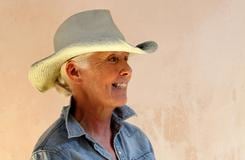
Harmony Hammond: Getty Research Institute
September 15, 2016
Image: Hammond, 2010, photo by Judith Cooper
Alexander Gray Associates is pleased to announce the acquisition of Harmony Hammond's (b.1944) archive by the Getty Research Institute (GRI). The archive includes correspondence, photographs, original source material for her art, professional papers, publication drafts, editioned prints, original artwork, files and a slide registry devoted specifically to lesbian artists. In addition to the archive, which was purchased by the GRI, Hammond has donated an extensive library of books and other publications related to art, feminism, and lesbian/gay/queer/trans studies.
“Harmony Hammond is not only an important pioneering artist, but a groundbreaking curator and art historian. Her artistic practice, scholarship, and dedication to the history of feminist and lesbian art and issues of difference have made her an extraordinarily influential scholar and artist,” said Thomas W. Gaehtgens, director of the Getty Research Institute. “We are honored that Hammond has chosen the Getty Research Institute to house her archive and I am certain that it will be of tremendous use to scholars.”
The Harmony Hammond Papers document all stages of her artistic career, including photographs, ephemera, and documentation of artwork and exhibitions in which she moreparticipated. Hammond has also included original early artwork as part of the archive. These include a complete set of her editioned prints, more than twenty pieces; two of her earliest paintings; as well as her early woven Hairbags (1972), dedicated to members of her feminist consciousness-raising group, and Shoe Poems (1977). The archive also includes original source material for her imagery, as well as journals with both writings and drawings, and agendas documenting her activities in the nineties.
Her papers also record her role in the feminist and lesbian art movements as writer, curator, and teacher, including her involvement as a founding member of the A.I.R. Gallery, the first feminist co-operative art space in New York City, and of the collective Heresies: A Feminist Publication on Art and Politics. There is also correspondence from many notable artists and writers, such as Louise Bourgeois, Rita Mae Brown, Judy Chicago, Jill Johnston, Ana Mendieta, Kate Millett, Linda Montano, Linda Nochlin, Howardena Pindell, Adrienne Rich, Faith Ringgold, May Stevens, and Faith Wilding. The files of correspondence with Lucy Lippard, Moira Roth, and Arlene Raven are particularly rich.
The Getty Research Institute
The Getty Research Institute is an operating program of the J. Paul Getty Trust. It serves education in the broadest sense by increasing knowledge and understanding about art and its history through advanced research. The Research Institute provides intellectual leadership through its research, exhibition, and publication programs and provides service to a wide range of scholars worldwide through residencies, fellowships, online resources, and a Research Library. The Research Library—housed in the 201,000-square-foot Research Institute building designed by Richard Meier—is one of the largest art and architecture libraries in the world. The general library collections (secondary sources) include almost 900,000 volumes of books, periodicals, and auction catalogues encompassing the history of Western art and related fields in the humanities. The Research Library's special collections include rare books, artists' journals, sketchbooks, architectural drawings and models, photographs, and archival materials.
The J. Paul Getty Trust
The J. Paul Getty Trust is an international cultural and philanthropic institution devoted to the visual arts that includes the J. Paul Getty Museum, the Getty Research Institute, the Getty Conservation Institute, and the Getty Foundation. The J. Paul Getty Trust and Getty programs serve a varied audience from two locations: the Getty Center in Los Angeles and the Getty Villa in Pacific Palisades.